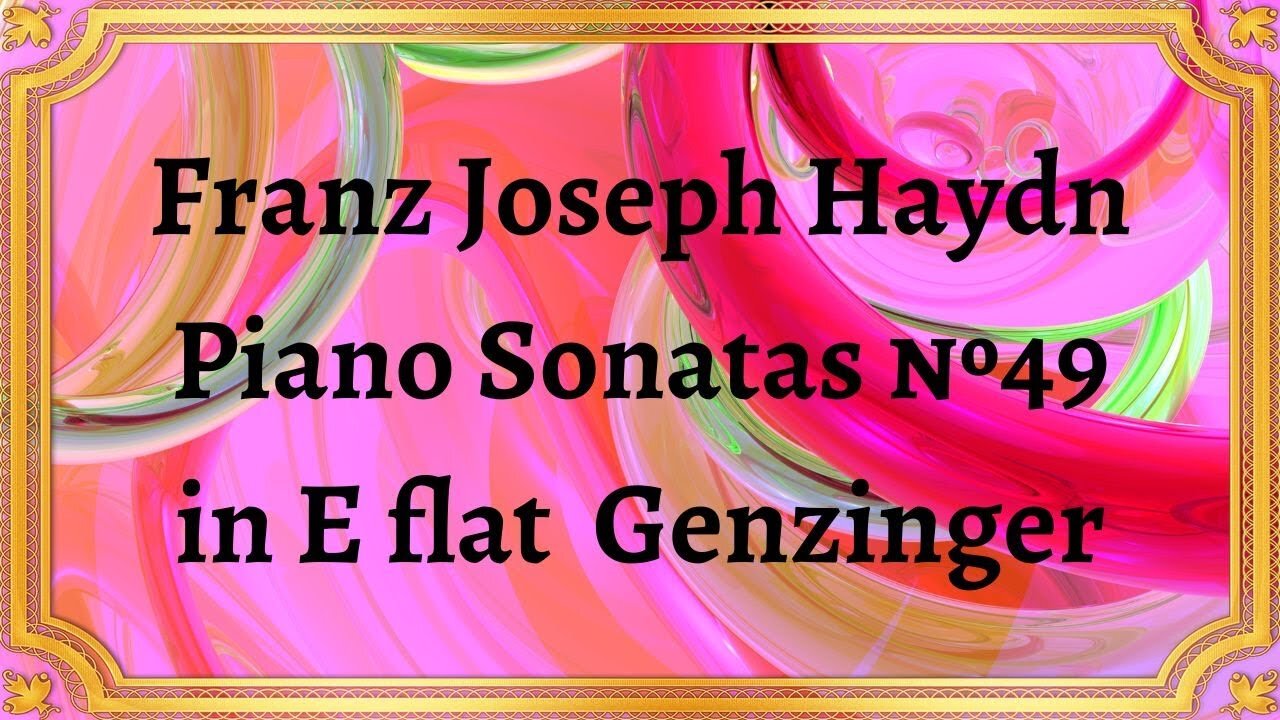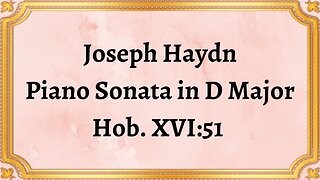Premium Only Content

Franz Joseph Haydn Piano Sonatas №49 in E flat Genzinger
#Haydn #PianoSonatas #ClassicalMusic #Composition #Genzinger #Eflat #MusicalLegacy #HistoricalContext #StructuralIntricacies #EmotionalDepth #Influence #ClassicalPiano #HarmonicProgression #ThematicDevelopment
Publication date 1951
Virginia Pleasants
Franz Joseph Haydn, a prominent figure in classical music, crafted a vast array of compositions that continue to captivate audiences. Among his notable works are the Piano Sonatas, each a testament to his genius and innovation.
Composed in the late 18th century, during Haydn's tenure with the Esterházy family, the Piano Sonatas No. 49 in E flat "Genzinger" emerged from a period of musical exploration and experimentation. It is believed that these sonatas were written for the accomplished pianists in the Esterházy court, providing a platform for their virtuosic displays and showcasing the capabilities of the piano as an instrument.
Haydn's Piano Sonatas No. 49 in E flat "Genzinger" comprise three movements: Allegro, Adagio e cantabile, and Finale: Tempo di Minuet. The first movement, Allegro, introduces a lively and spirited melody, showcasing Haydn's mastery of thematic development and harmonic progression. The second movement, Adagio e cantabile, offers a contrasting mood with its introspective and lyrical nature. Haydn's delicate phrasing and expressive melodies in this movement create a profound emotional impact. The final movement, Finale: Tempo di Minuet, concludes the sonatas with a charming and dance-like character, demonstrating Haydn's ability to infuse his compositions with both elegance and joy.
Haydn's Piano Sonatas No. 49 in E flat "Genzinger" exemplify his ability to evoke a range of emotions within his compositions. The contrasting moods and dynamic shifts within each movement allow listeners to experience a captivating journey of emotions, from exuberance and introspection to elegance and joy. Haydn's ingenious musical techniques, combined with his innate understanding of human emotions, create a profound and enduring impact on those who engage with his music.
The Piano Sonatas No. 49 in E flat "Genzinger" by Haydn have left a lasting impact on the development of classical piano music. Haydn's innovative use of structure, harmonic progression, and thematic development paved the way for future composers, influencing the likes of Ludwig van Beethoven and Wolfgang Amadeus Mozart. These sonatas showcase Haydn's ability to push the boundaries of musical expression, leaving an indelible mark on the classical music landscape and inspiring generations of musicians.
Conclusion:
Franz Joseph Haydn's Piano Sonatas No. 49 in E flat "Genzinger" stand as a testament to his musical brilliance. Through their historical significance, structural intricacies, and emotional depth, these sonatas continue to captivate audiences and inspire musicians. Haydn's ability to create compositions that resonate with universal emotions, while pushing the boundaries of musical expression, ensures that his Piano Sonatas No. 49 in E flat "Genzinger" remain a cherished part of the classical music repertoire.
You have the opportunity to support the channel https://destream.net/live/RadSiarAl/donate
-
 6:07
6:07
Classical music_Music Inspiration
1 month agoJoseph Haydn Piano Sonata in D Major, Hob. XVI:51
861 -
 1:46:14
1:46:14
Kim Iversen
7 hours agoTrump to Zelenskyy: 'You're Gambling with World War III'
67.8K108 -
 55:28
55:28
Glenn Greenwald
9 hours agoGlenn Reacts to Trump-Zelensky Exchange and Takes Q&A from our Members | SYSTEM UPDATE #415
111K198 -
 4:26:54
4:26:54
Nerdrotic
11 hours ago $34.34 earnedMarvel PANIC MODE! Kathleen Kennedy GONE?! Hollywood DEI Dead | Friday Night Tights 342 Nick Freitas
127K36 -
 1:30:03
1:30:03
Flyover Conservatives
1 day agoZelensky Fail... God Called IT!; From Prison to the White House: Angela Stanton King’s Unbelievable Redemption Story | FOC Show
45.9K6 -
 1:06:14
1:06:14
IsaacButterfield
10 hours ago $2.00 earnedFree Speech Is Dead | Did Trump Go Too Far? | Sexist Job
41.4K18 -
 1:02:59
1:02:59
Sarah Westall
13 hours agoEpstein Files, Dueling Cabal Factions and Gold from Ancient Civilizations w/ Dave Hodges
71K19 -
 3:15:08
3:15:08
I_Came_With_Fire_Podcast
11 hours ago“Trump-Zelensky BEATDOWN | Europe BUILDS MUSCLE | NEWSCUM Podcast”
17.4K1 -
 41:25
41:25
CatfishedOnline
11 hours ago $1.84 earned23-Yr-Old Drove 2,650 Miles to Meet Online Girlfriend in Romance Scam
40.1K4 -
 1:56:18
1:56:18
Bare Knuckle Fighting Championship
2 days agoCountdown to BKFC FIGHT NIGHT ALBUQUERQUE & FREE LIVE FIGHTS!
35.7K2